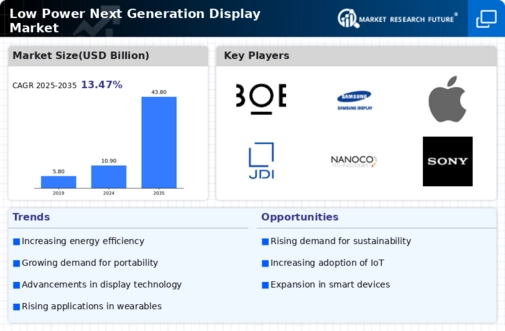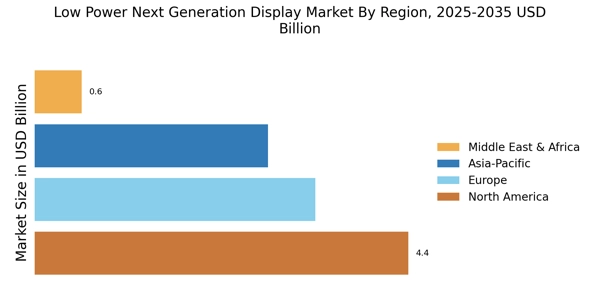Government Regulations
Government regulations are becoming an influential factor in the Low Power Next Generation Display Market. As countries implement stricter energy efficiency standards, manufacturers are compelled to develop displays that meet these requirements. Regulations aimed at reducing carbon footprints and promoting energy conservation are driving the adoption of low power display technologies. For example, initiatives such as the Energy Star program encourage the production of energy-efficient electronics, which includes displays. Compliance with these regulations not only enhances product appeal but also opens up new market opportunities for manufacturers. As governments worldwide continue to prioritize sustainability, the Low Power Next Generation Display Market is expected to benefit from these regulatory frameworks, fostering innovation and growth in energy-efficient display solutions.
Sustainability Initiatives
The Low Power Next Generation Display Market is increasingly influenced by sustainability initiatives. As consumers and manufacturers alike prioritize eco-friendly solutions, the demand for displays that consume less energy is on the rise. This shift is evident in the growing adoption of organic light-emitting diode (OLED) technology, which is known for its lower power consumption compared to traditional LCDs. Reports indicate that OLED displays can reduce energy usage by up to 30%, making them a preferred choice for environmentally conscious consumers. Furthermore, manufacturers are investing in sustainable production processes, which not only minimize waste but also enhance the overall appeal of low power displays. This trend is likely to continue, as regulatory frameworks increasingly favor energy-efficient technologies, thereby propelling the Low Power Next Generation Display Market forward.
Technological Advancements
Technological advancements play a pivotal role in shaping the Low Power Next Generation Display Market. Innovations in display technologies, such as microLED and advanced LCDs, are driving the development of displays that offer superior performance while consuming less power. For instance, microLED technology is emerging as a frontrunner due to its ability to deliver high brightness and contrast with minimal energy consumption. Market data suggests that the microLED segment is expected to witness a compound annual growth rate (CAGR) of over 40% in the coming years. These advancements not only enhance user experience but also align with the growing demand for energy-efficient solutions. As manufacturers continue to invest in research and development, the Low Power Next Generation Display Market is poised for significant growth, driven by these cutting-edge technologies.
Consumer Electronics Demand
The demand for consumer electronics is a significant driver of the Low Power Next Generation Display Market. With the proliferation of smartphones, tablets, and smart TVs, consumers are increasingly seeking devices that offer high-quality displays without compromising battery life. The trend towards portable and energy-efficient devices has led to a surge in the adoption of low power display technologies. Market analysis indicates that the smartphone segment alone is projected to account for over 50% of the total display market by 2026. This growing consumer preference for energy-efficient displays is compelling manufacturers to innovate and integrate low power technologies into their products. As a result, the Low Power Next Generation Display Market is likely to experience robust growth, fueled by the escalating demand for energy-efficient consumer electronics.
Integration of Smart Technologies
The integration of smart technologies is a key driver in the Low Power Next Generation Display Market. As the Internet of Things (IoT) continues to expand, the demand for displays that can seamlessly connect with smart devices is increasing. Low power displays are particularly well-suited for IoT applications, as they require minimal energy while providing essential information. This trend is evident in smart home devices, wearables, and automotive displays, where energy efficiency is paramount. Market forecasts suggest that the IoT sector will significantly contribute to the growth of the low power display market, with an expected CAGR of over 25% in the next few years. The convergence of smart technologies and low power displays is likely to create new opportunities for innovation, thereby propelling the Low Power Next Generation Display Market into a new era of connectivity and efficiency.

















Leave a Comment